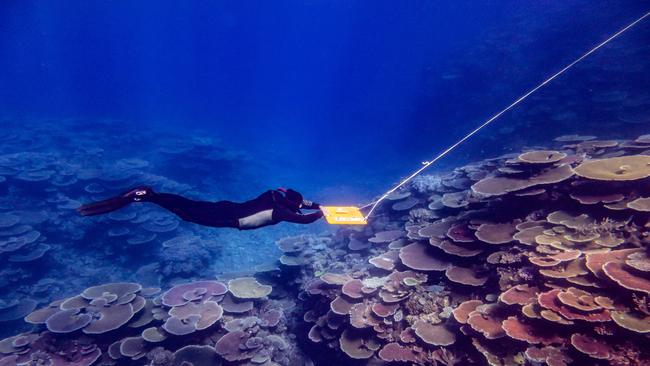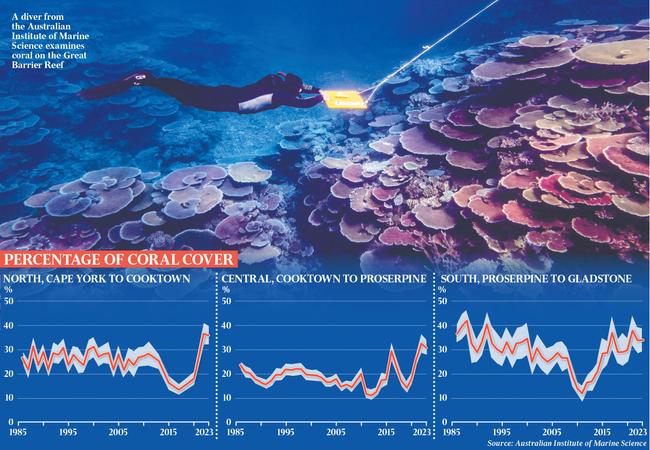Great Barrier Reef coral at record levels despite bleaching
Hard coral cover on the Great Barrier Reef has remained at a historic high level despite a widespread bleaching event in 2022, a survey has found.

Hard coral cover on the Great Barrier Reef has remained at a historic high level despite a widespread bleaching event in 2022, the latest Australian Institute of Marine Science long-term survey has shown.
Coral cover in the northern and central regions of the reef reached their highest levels since monitoring began 37 years ago in 2022. AIMS said small decreases in cover in 2023 were within the margin for error for the survey results but the pause in reef recovery illustrated the sensitivity of the reef to stresses, including bleaching, crown of thorns starfish outbreaks and cyclones.
Marine scientist Peter Ridd said the high coral cover confirmed that the GBR was in good health. “The fabulous condition of the reef demonstrates that the public has been systematically misled by many science institutions about the condition of the reef,” Dr Ridd said.
“The four supposedly devastating bleaching events since 2016 clearly did not kill much coral and it is time for governments and scientists to stop telling the world that the reef is in poor condition and start to be proud of it, and our management of it.”
The long-term monitoring program is the most detailed and longest running survey of the GBR and is conducted by towing divers over reefs to visually inspect them, mainly on the mid and outer shelf.
The 111 reefs surveyed provide a representative sample of the reef, which includes many bioregions and all the management zones of the GBR Marine Park.
Hard coral cover in the northern section of the reef, north of Cooktown, in 2023 was 35.7 per cent; the central region was 30.8 per cent and the southern region 33.8 per cent.

Because coral reef consists of more than just hard coral including other corals, sponges, algae, sand, rock and invertebrates, AIMS defines 30 to 50 per cent hard coral cover as high value based on historical surveys.
The institute said it was relatively rare for GBR reefs to have 75 per cent to 100 per cent cover.
In the latest survey, only one reef had cover of less than 10 per cent while nearly half of the surveyed reefs (49 out of 111) had hard coral cover levels between 10 and 30 per cent. More than one-third of reefs had hard coral cover levels between 30 and 50 per cent and 18 reefs had hard coral cover between 50 and 75 per cent.
AIMS said most coral reefs of the GBR demonstrated resilience in the absence of acute disturbances, showing the ability to recover from events causing widespread mortality.
The institute said the positive news on coral cover did not mean there was no reason for concern. AIMS research program director David Wachenfeld said the pause in recovery showed that even relatively milder mass bleaching events had consequences.
“The 2022 coral bleaching event was not as severe as the 2016 or 2017 events but caused enough mortality to pause recent regional gains in hard coral cover,” Dr Wachenfeld said.
“Heat stress during the bleaching event also likely had sub-lethal effects, including reductions in coral growth and reproduction. Conditions were relatively mild in the 2023 summer with low levels of coral bleaching and no cyclones. However, we’re only one large scale disturbance away from a rapid reversal of recent recovery.
“The reef remains a wonderful, complex and beautiful system but it is at increased risk with climate change driving more frequent and severe bleaching events, putting increasing pressure on the ecosystem’s resilience.”
Release of the AIMS report follows a decision by UNESCO not to proceed with a vote to put the GBR on the World Heritage in danger list.
The World Heritage Committee will reconsider the issue next year.




To join the conversation, please log in. Don't have an account? Register
Join the conversation, you are commenting as Logout